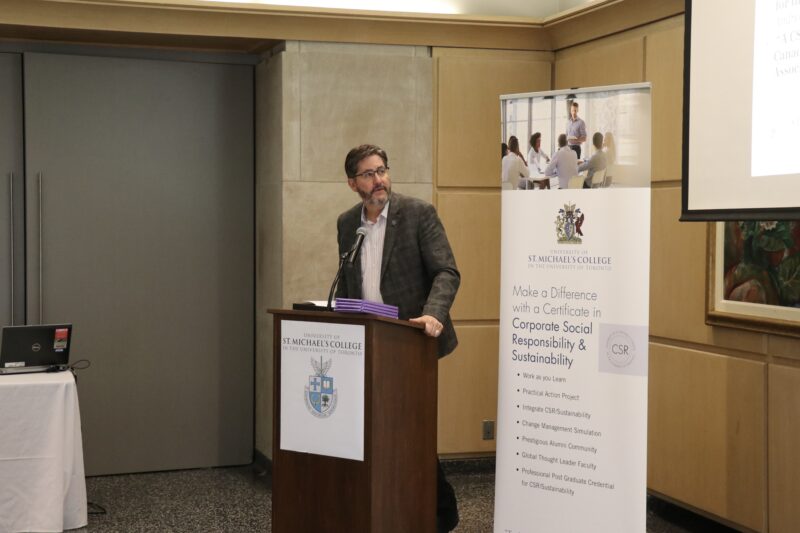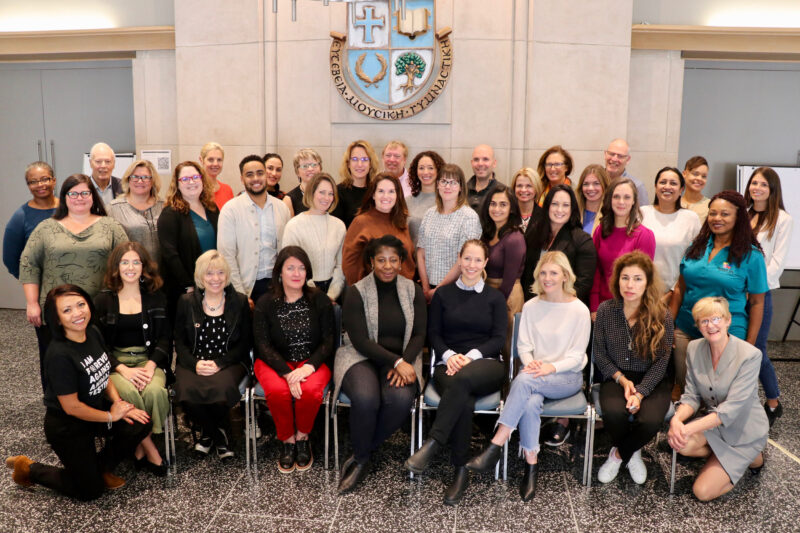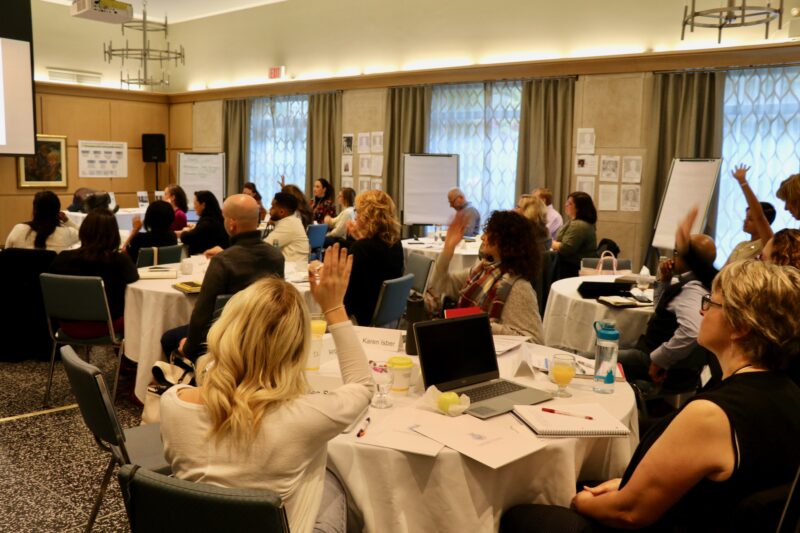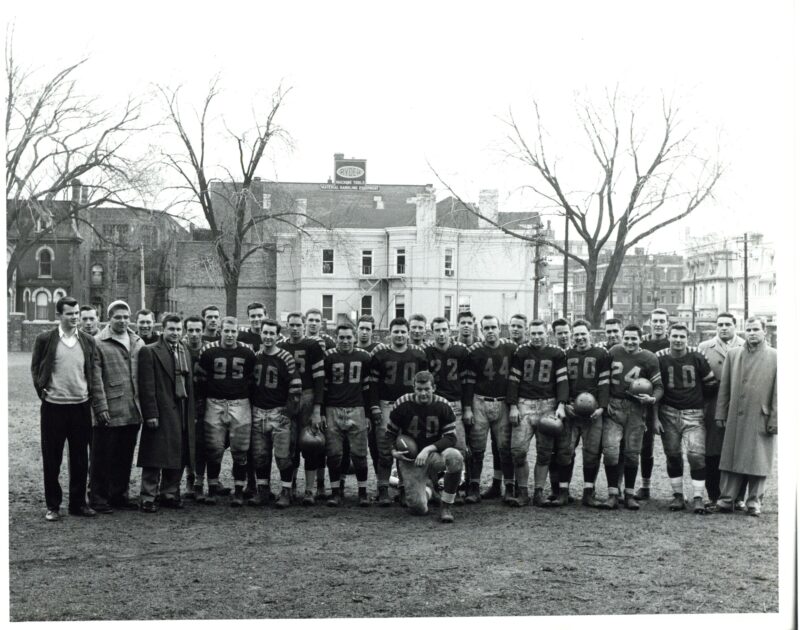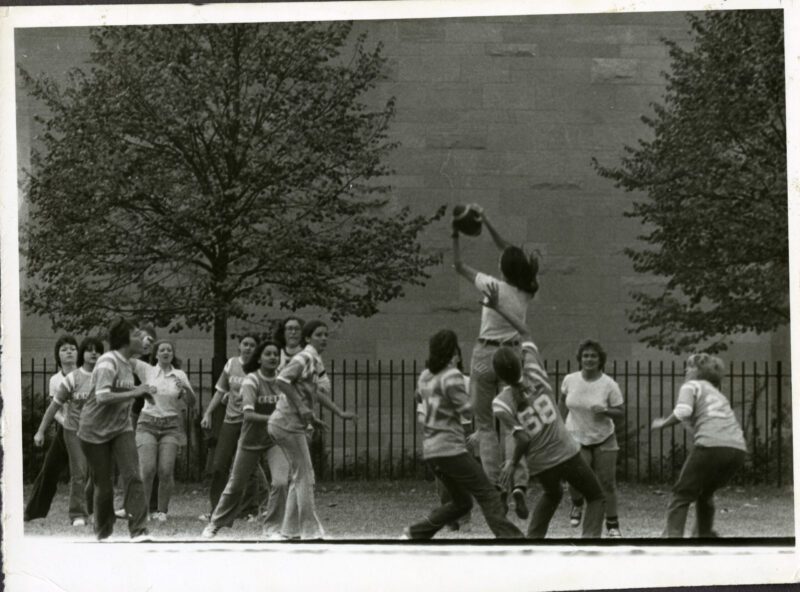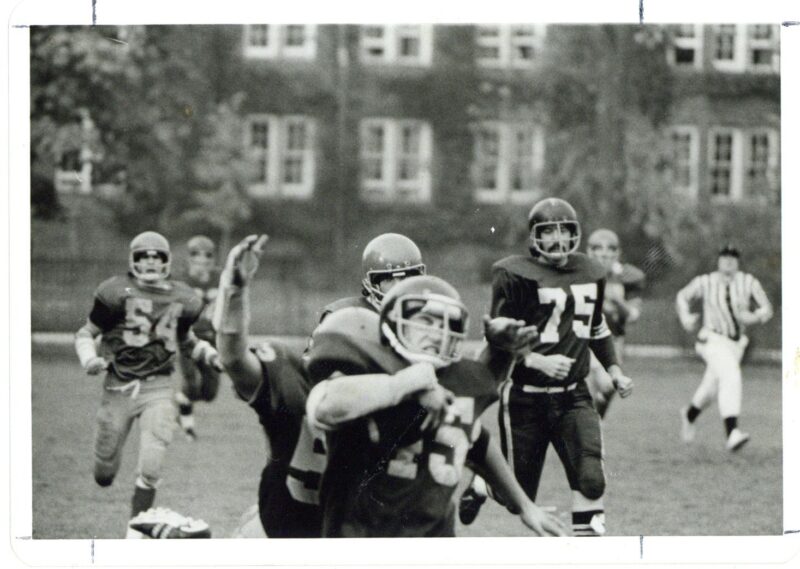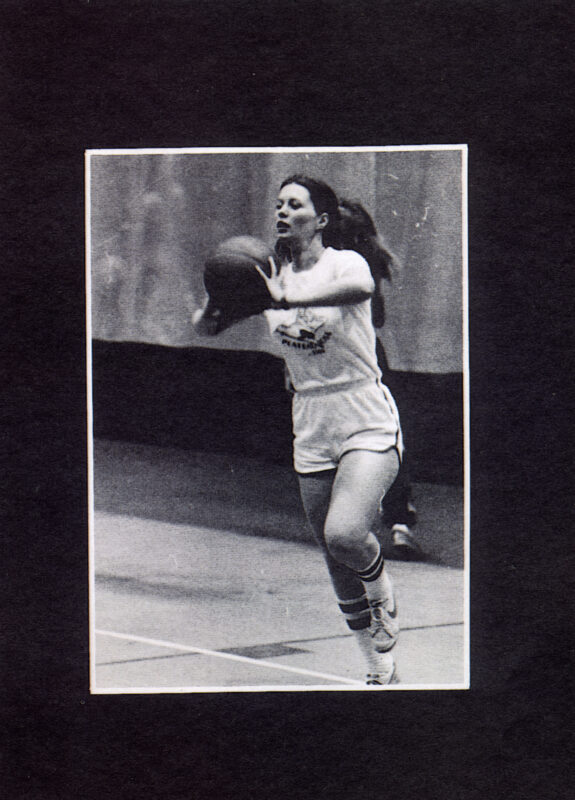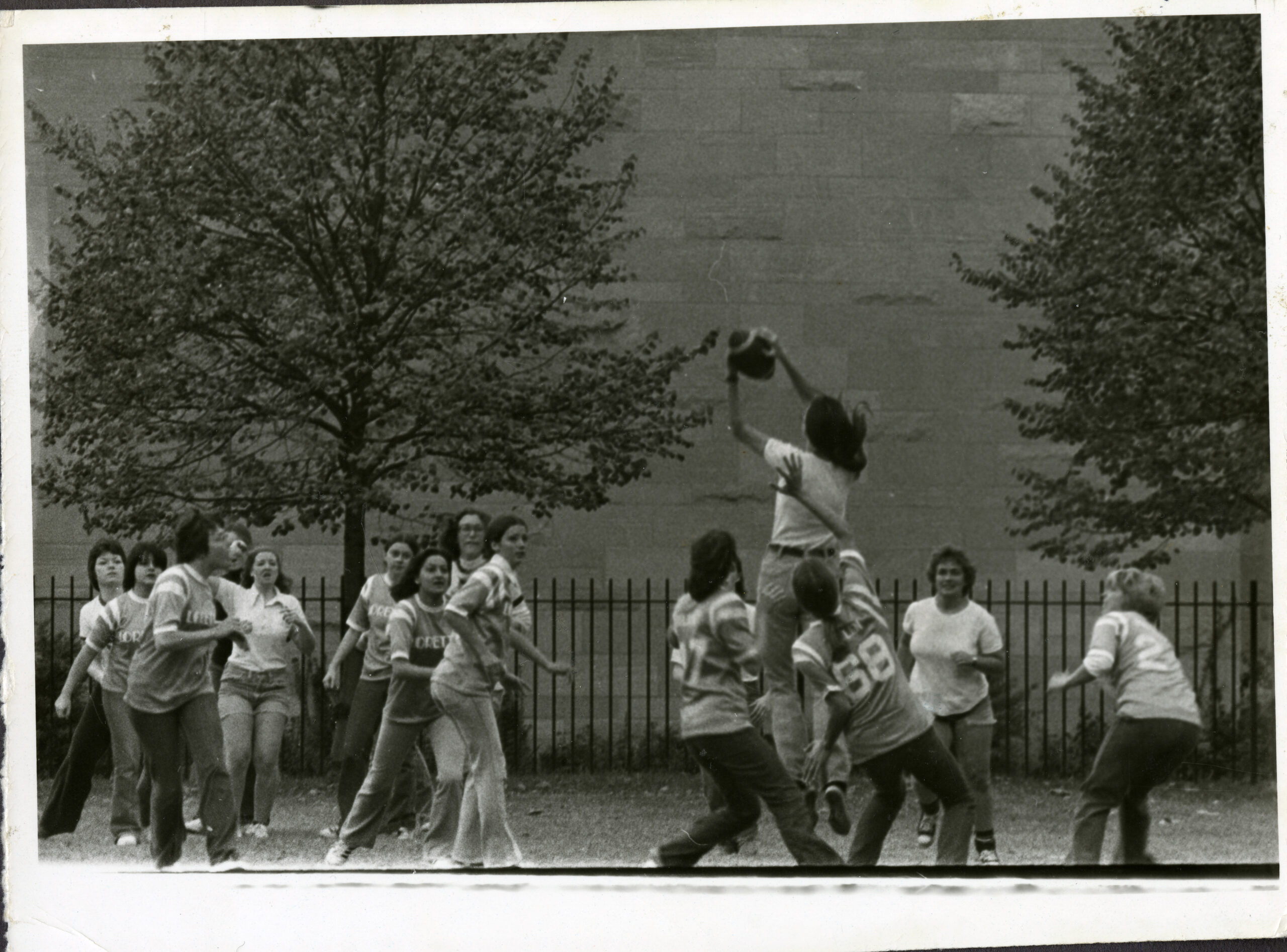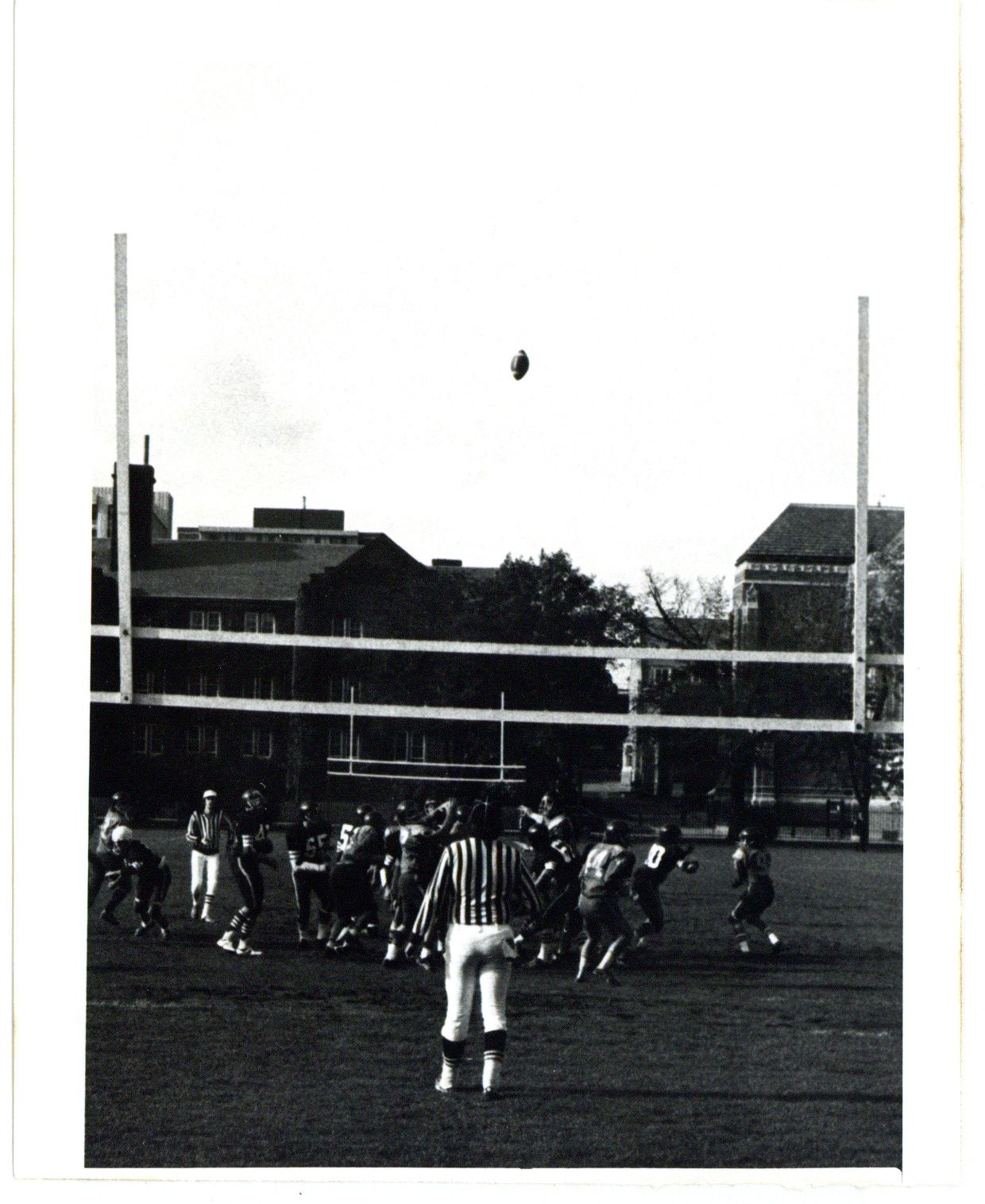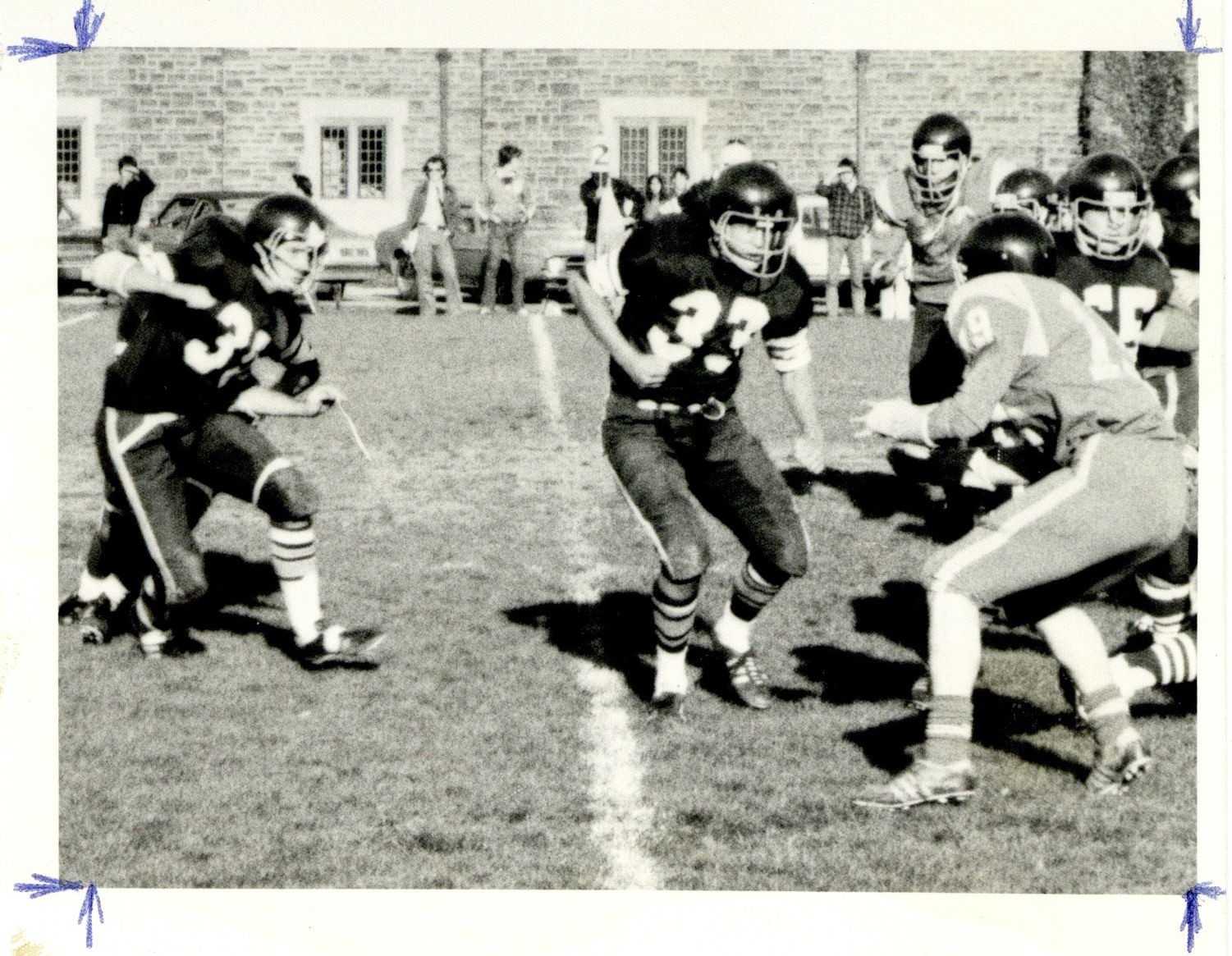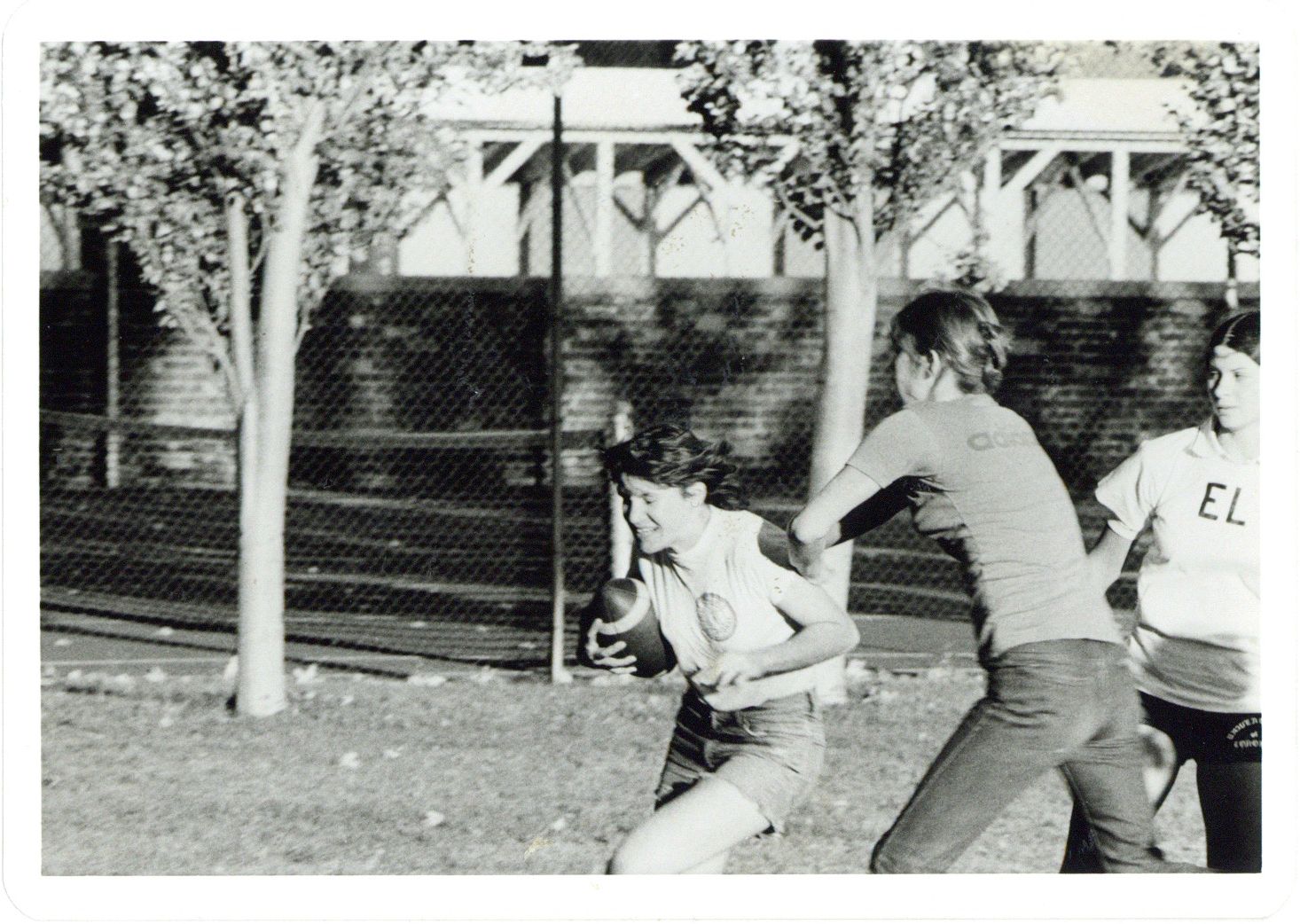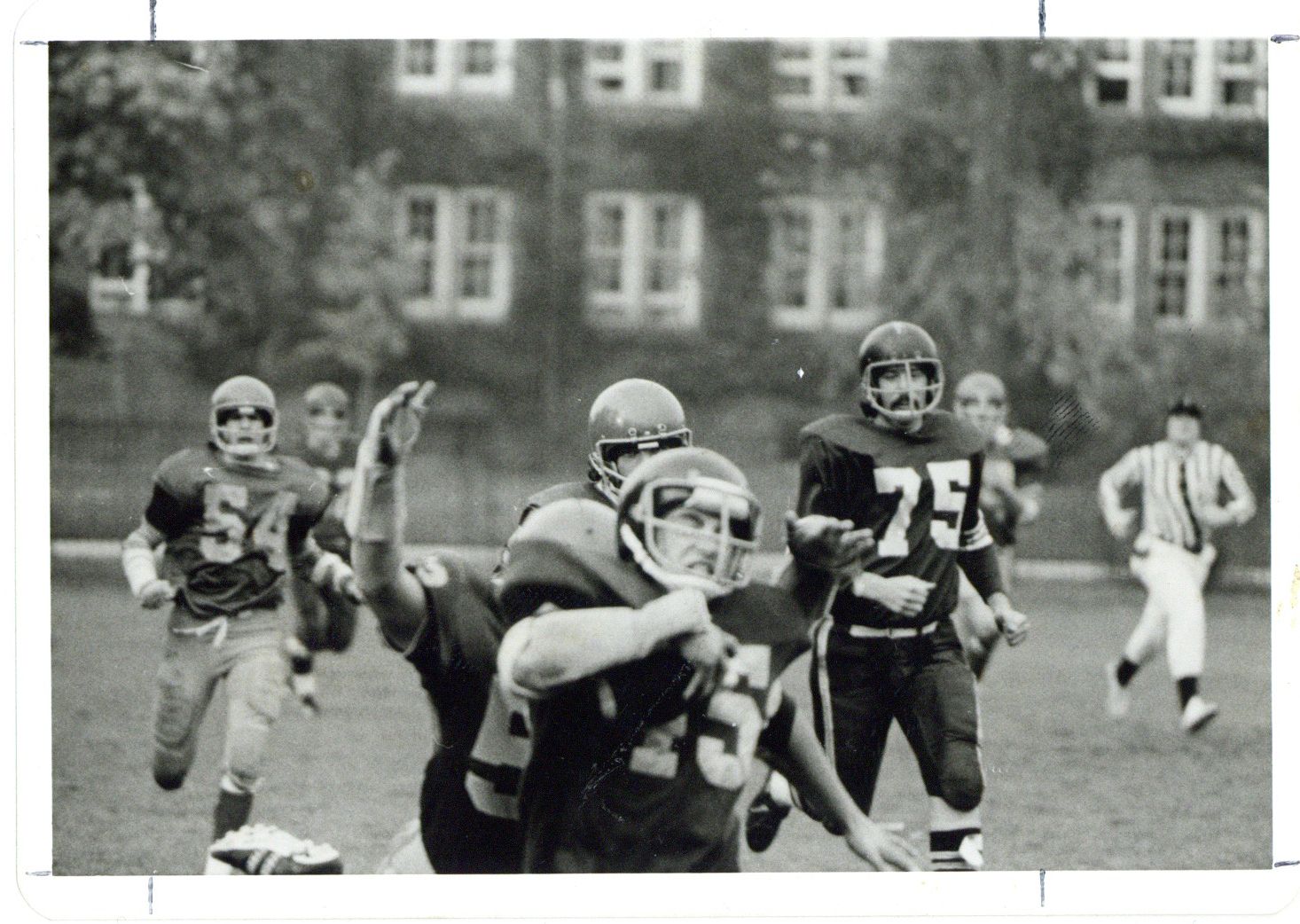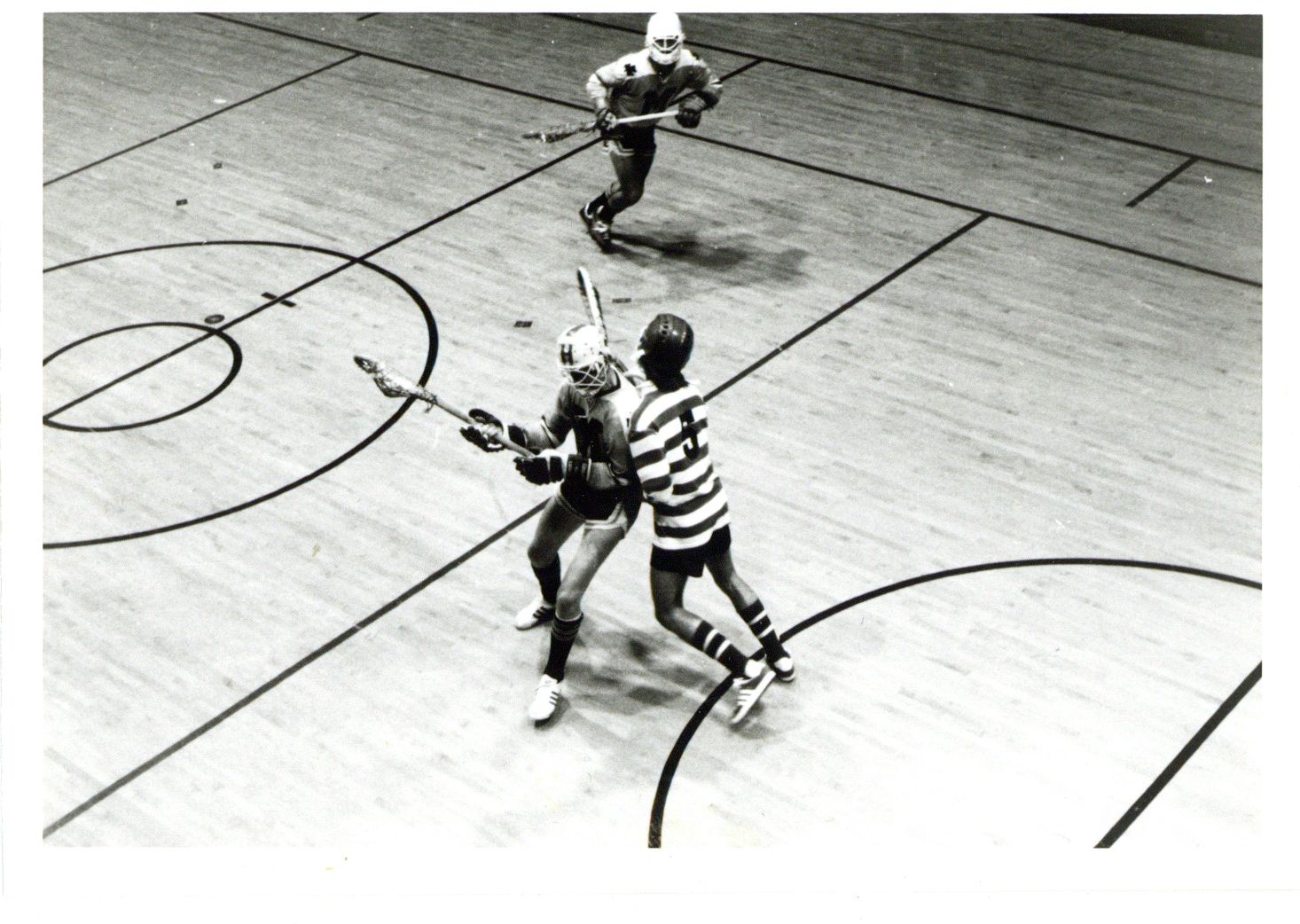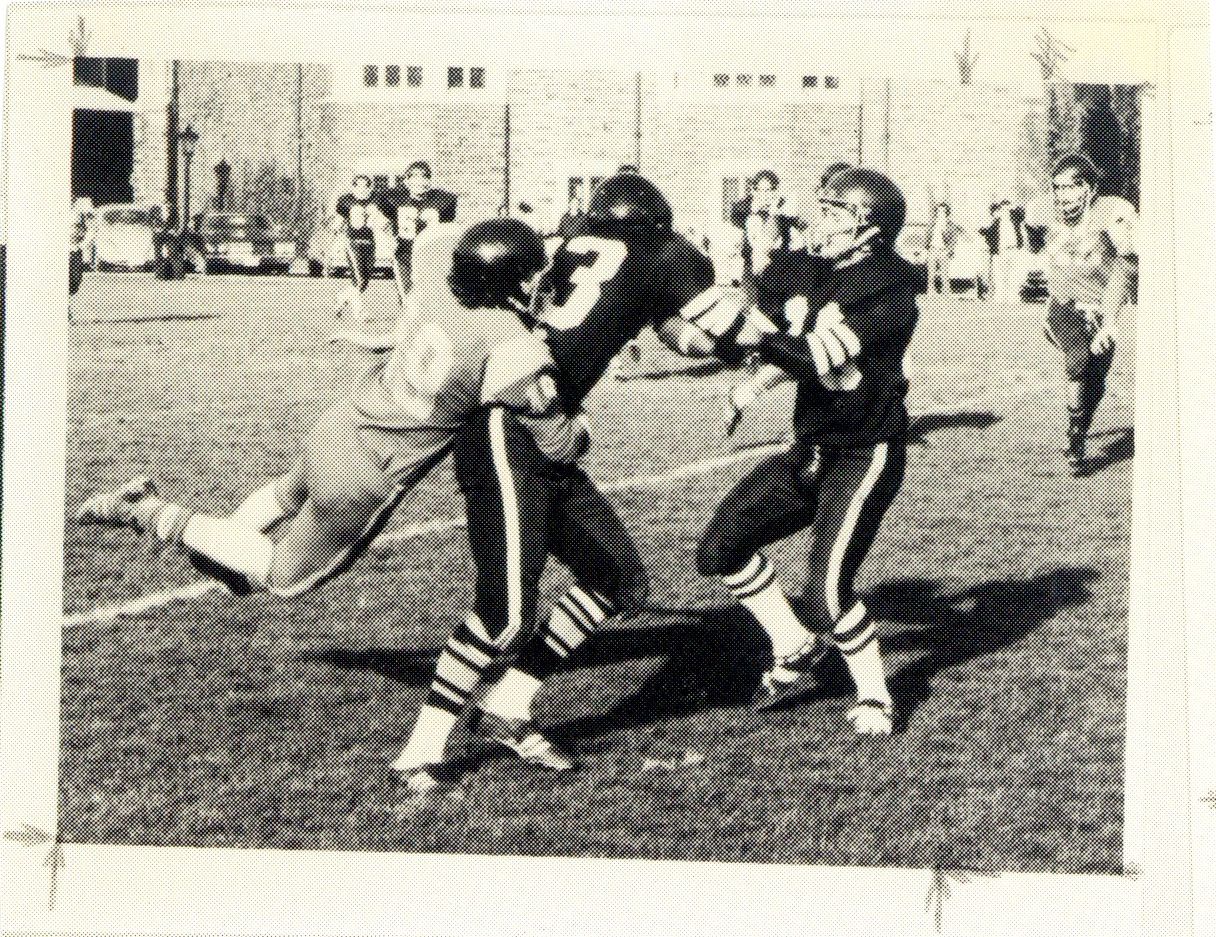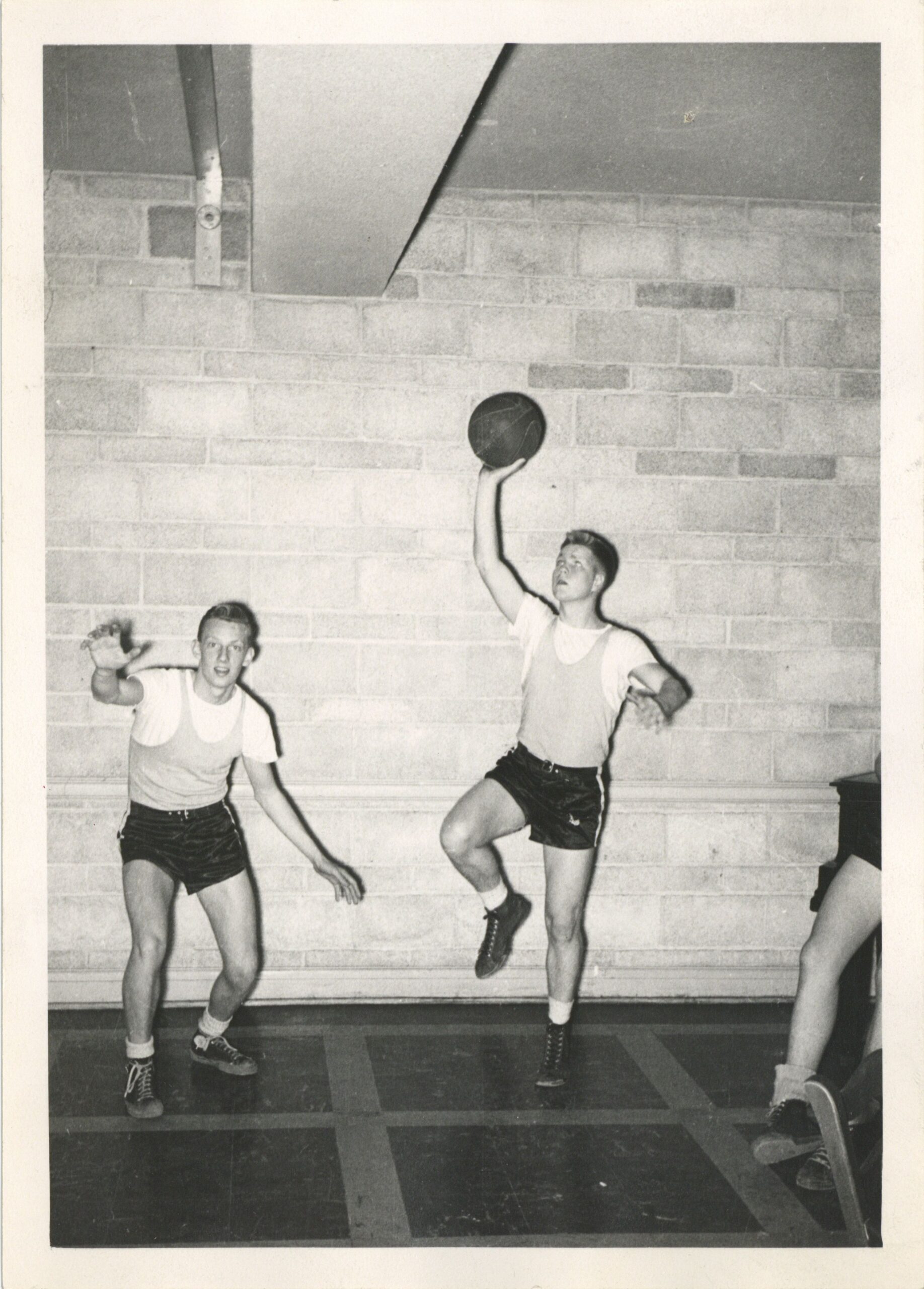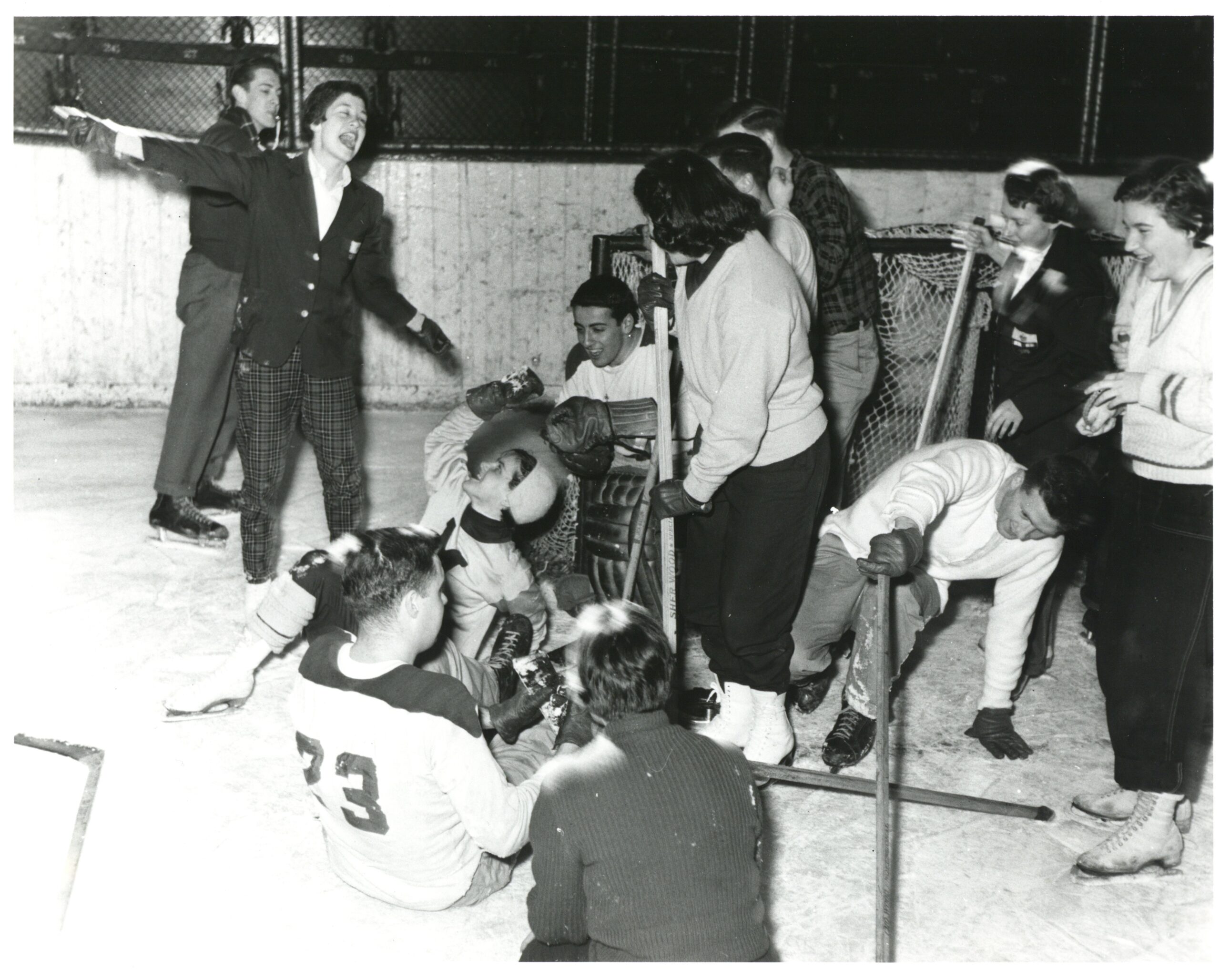In this story from the Spring 2021 President’s Report, Chief Administrative Officer Effie Slapnicar discusses how St. Michael’s involvement with UNIE reflects the way sustainability is being woven into all aspects of the College’s culture.
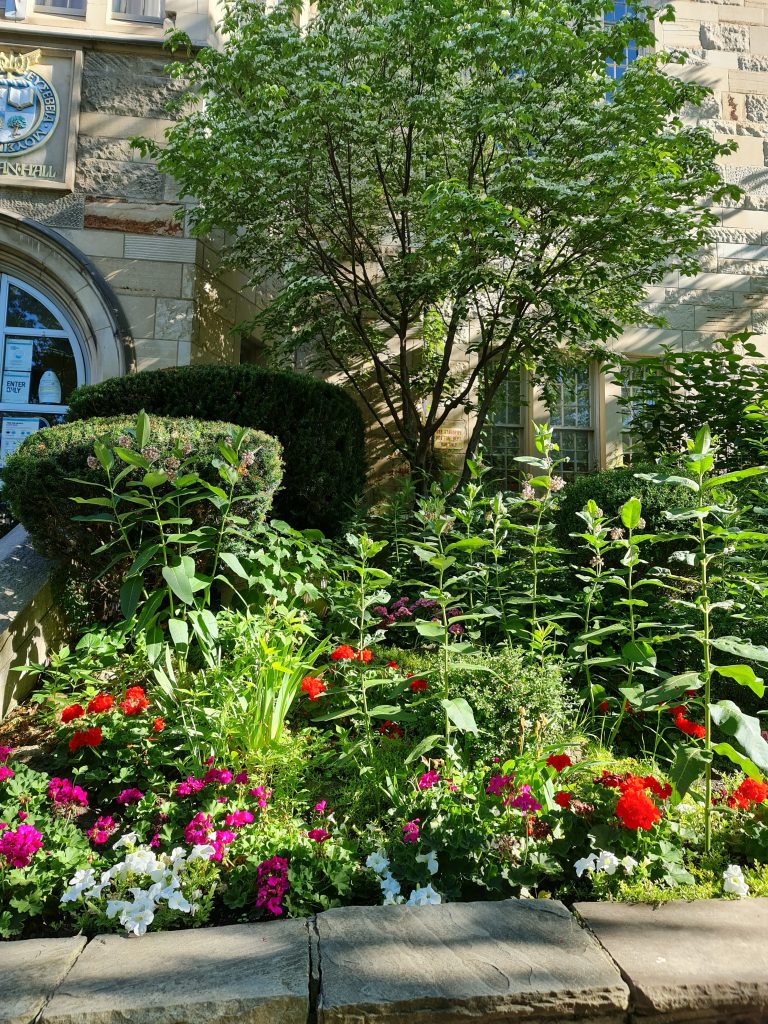
The University of St. Michael’s College knew it was a wise fiscal move to become a member of the Shareholder Association for Research & Education (SHARE). Belonging to the non-profit investor advocacy organization, which St. Mike’s joined in 2016, seemed a good way to prioritize sustainability and climate justice in the university’s investing strategy while building relationships with like-minded institutions.
What hadn’t fully been anticipated, says Effie Slapnicar, St. Michael’s Chief Administrative Officer, was the degree to which conversations about ethical investing would have trickle-down effects on the community, prompting much broader conversations and initiatives about sustainability initiatives across the university.
“Belonging to SHARE is a good way for us to use investments to advance the ESG (Environmental, Social and Governance) issues we want to raise,” says Slapnicar, who says an E, S & G committee was struck at St. Michael’s in 2017 to review quarterly reports generated by SHARE, as well as to discuss related questions. “Often people think that you need to sacrifice earnings to make a change, but SHARE serves as a mediator, allowing us a seat at the corporate table to raise environmental and social concerns we have. We are maintaining healthy returns while also addressing questions of sustainability.”
Now, St. Michael’s has gone a step further and become a charter member of the University Network for Investment Engagement (UNIE), a collective of Canadian universities under the SHARE umbrella whose role is to engage corporations on questions of reducing greenhouse gas emissions and pursuing sustainable finance, responsible climate policy, and just transitions through the initiative.
“We believe that collectively, with other Canadian universities participating, we will have a stronger voice in areas of climate change that are important to our community,” Slapnicar says. “As shareholders, we have the opportunity to use our position to influence corporate behaviour, and together with our colleagues across Canada we want to use that influence to accelerate Canada’s transition to a zero-carbon economy.”
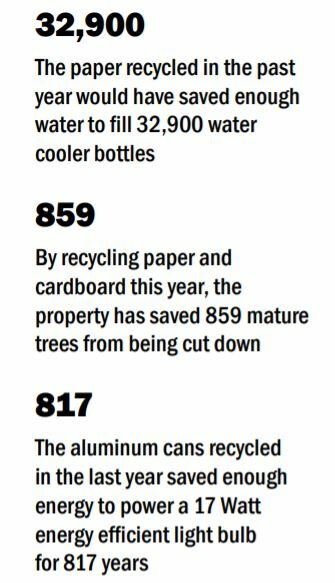
UNIE, which involves a number of stakeholders, including York, McGill, McMaster, and Carleton universities, will focus both on reducing greenhouse gas emissions and accelerating the transition to a low carbon economy.
“These universities are showing leadership in addressing the climate crisis. Working together in one program amplifies each institution’s voice and leverages their power to bring about change,” says Kevin Thomas, Chief Executive Officer at SHARE.
While ongoing financial fitness is a critical factor in ensuring the long-term health of St. Mike’s, the ESG Committee also discusses more local issues.
“We often find ourselves asking what we can do in our own backyard (to promote sustainability) and what we can control,” Slapnicar says. “We have a responsibility not only to our current students but to our future ones, too, as well as to many, many other people, including all those who see our beautiful campus as an oasis in the middle of a big, bustling city.”
“Sustainability is important to us and it affects how we approach things. For example, it influenced our hiring of Director of Facilities Michael Chow, as he really understands sustainability and has an eye for projects while also appreciating the need to work within a limited budget,” she says.
Duncan Buttenshaw, St. Mike’s new Director of Finance, is another example of how our environmental and social goals are reflected in our hiring, Slapnicar says, noting that Buttenshaw is in the final stages of his MBA with a specialization in Social Impact from the University of New South Wales.
Now, as the university eyes such issues as more efficient recycling and environmentally friendly furniture and supplies, it also thinks about its procurement policy as a way to enhance St. Mike’s social impact. For example, a company that embraces diversity might be given added points in the procurement process, she notes.
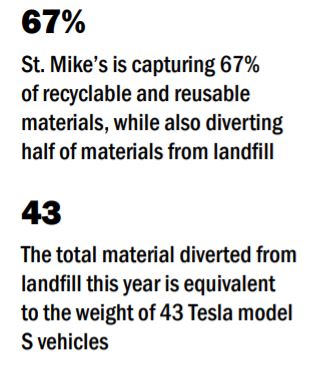
As an example, Slapnicar notes that when the university was looking at new furniture for the recently renovated Brennan Hall, the original plan was to order from the United States. But when it became apparent the order would be delayed, the university found Canadian-made furniture, saving money and cutting the environmental toll of a long delivery haul, an idea now being actively embraced.
“It’s astounding the way sustainability is being woven into the culture here,” says Slapnicar, who says it fits with a community she finds to be “consultative.”
“Who better to ask than the people on the front lines? Often I will hear a senior manager respond to a discussion by saying, ‘I’ll need to consult my team and get back to you’ and then the person will return with great ideas because the community cares and is always ready to help,” she says, noting the additional value of staff feeling appreciated, knowing their ideas are valued and acted upon.
“Our campus reflects the past and the future and we are respectful of that,” she says. “We know both the students and the broader community value our grounds, so we respect the heritage aspect while always working with an eye to a more beautiful, efficient campus. We are so excited about the changes coming.”
From University of St. Michael’s College President’s Report, Spring 2021
In this story from the Spring 2021 President’s Report, Registrar and Director of Student Services Giancarlo Mazzanti discusses the range of supports and services that students receive at St. Michael’s.
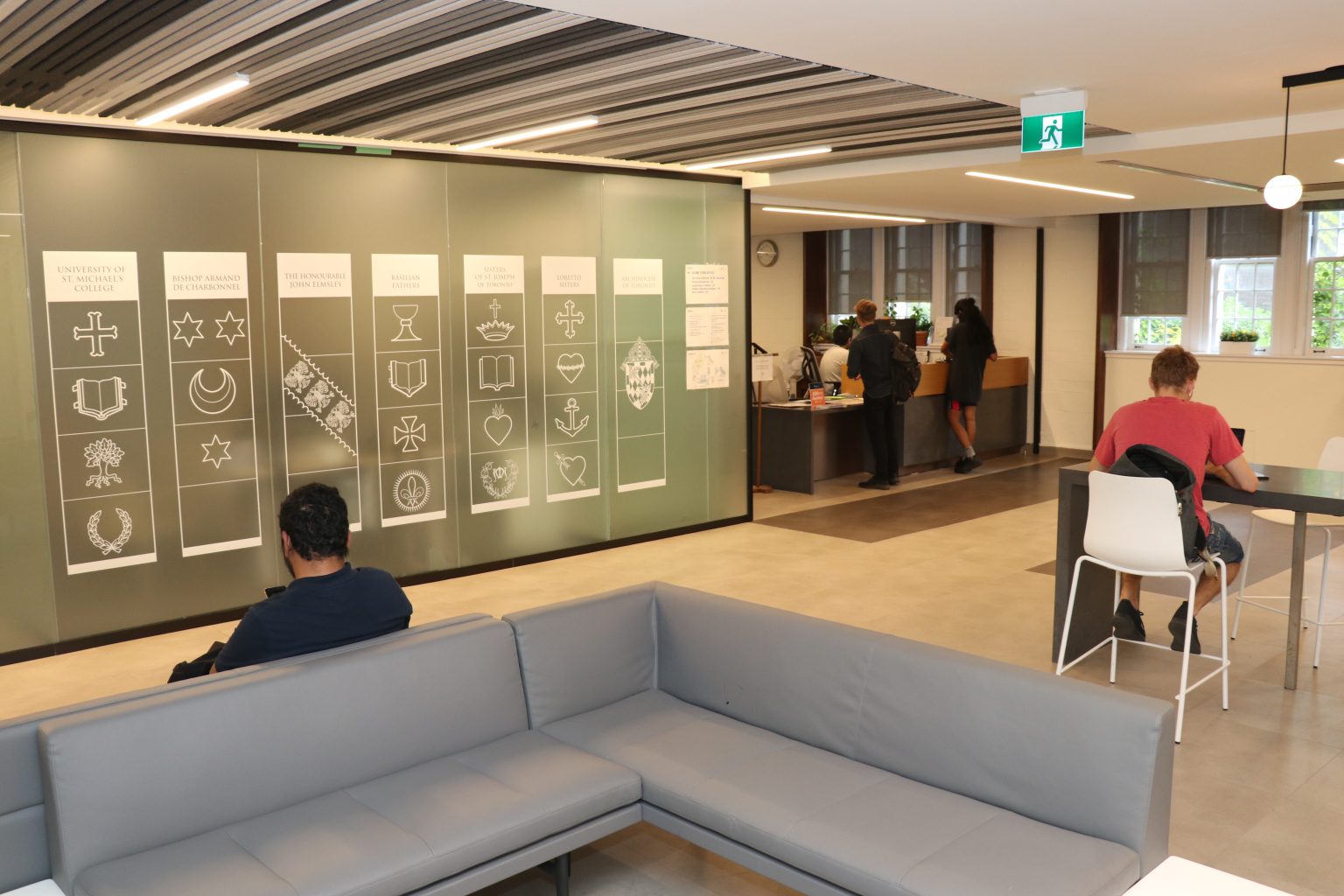
Giancarlo Mazzanti was sitting in a town square in Germany when he was tapped on the shoulder by a passerby. The man had seen Mazzanti’s St. Mike’s jacket and, as a fellow alumnus, wanted to make the connection. The anecdote, Mazzanti says, reflects the significance of profile the University of St. Michael’s College has not only locally but also worldwide.
“We have a great reputation around the world,” he says, noting it’s not unusual for him to hear from potential students in Switzerland, Hong Kong and New Jersey all in the same week. “We have a wonderful history, but we are also creating history, both with stellar students and with members of our alumni who are leaders in the public eye, whether in politics, health care, education, business or any of the endless places St. Michael’s alumni find themselves.”
Mazzanti, the university’s Registrar and Director of Student Services, says there are many reasons why St. Mike’s is such a draw for students, from its reputation as Canada’s top Catholic university to its convenient location in the centre of Toronto and its status as a federated college within the University of Toronto, which is consistently ranked among the top schools in the world.
Students are drawn by a reputation for strong academics, including the SMC One programs for first-year students, which promise unique course offerings and, in healthy times, international travel. Another draw is the recent increase in the number of full-time faculty members, all with exceptional profiles.
“These are the type of professors who appeal to high-flying students,” he says. “We are part of current conversations and our courses speak to that.”
The John M. Kelly Library, one of the U of T’s largest, offers plenty of study space and a ground-floor café. Students like to know they are just steps from the library, he says.
But Mazzanti thinks another crucial reason students are drawn to study and live at St. Mike’s is a reputation for a caring, welcoming environment that helps them achieve their best academically and socially. The result is that students graduate having developed skills that serve them—and their neighbours—throughout their lives.
“The richness of our community offers a diversity of debate, a chance to learn about other people’s lives and experiences, whether you’re sitting in the dorm common room or stretched out on the grass in the quad. This kind of knowledge is essential to our students’ futures.”
Students are also able to access a strong range of supports at St. Mike’s.
“Consider our First Year Check-in Program, which pairs incoming students with professors. Students have the opportunity to reach out to the professor assigned them for an informal chat or two,” he says. “It’s not specifically about academics, but it’s a great way for students to get used to speaking with professors, and for them to know they have someone they can go to if they are finding it hard to navigate university.”
But the first-year program is just one of many supports the school offers students. As demonstrated so well during the pandemic, when they quickly adjusted to the new normal of connecting with students all over the world, St. Mike’s academic advisors are dedicated to helping students with course and program selection and scheduling.
And there is plenty of help for students who are finding the adjustment to university expectations challenging. St. Mike’s provides access to academic learning strategists and wellness counsellors, who can all help students discover their own most successful ways of learning, how to adapt to university expectations, and how to get the most out of their academic life.
Similarly, the writing centre offers one-on-one appointments for students looking for guidance on all aspects of the writing process, from researching and outlining to drafting and editing. There are also supports in place for math and computer science students.
And while not all students applying to—or attending—St. Mike’s are Catholic, Mazzanti says there is a deep appreciation for the school’s roots, and an awareness among those of other religions that St. Mike’s is a school that understands the importance of faith and respects those who practise, regardless of background.
“We invite conversations with people of all faiths. We are a microcosm of the world as it could be,” says Mazzanti. “That’s who we are, and it is a privilege to be of service to others.”
From University of St. Michael’s College President’s Report, Spring 2021
In this story from the Spring 2021 President’s Report, St. Michael’s prof Dr. J.O. Richard discusses the role the Christianity and Culture Club has had in enriching community for students in the St. Michael’s-sponsored program.
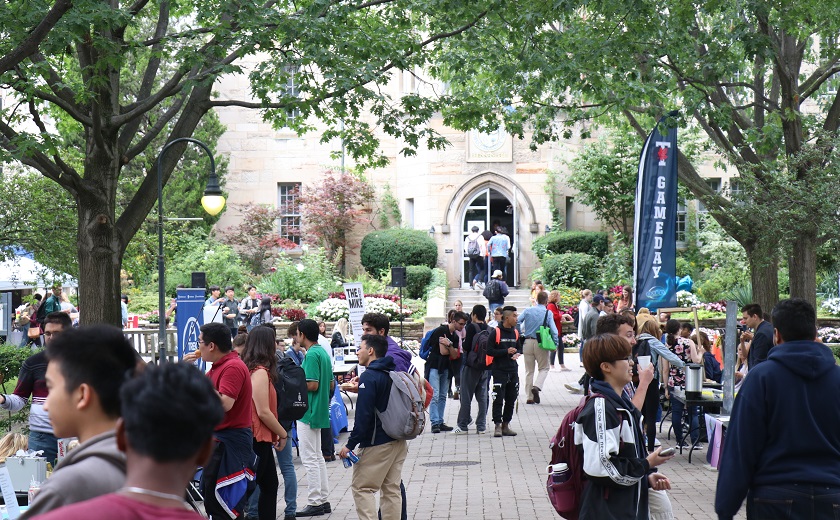
The Christianity and Culture Club is an informal, student-run weekly gathering during the Fall and Winter semesters. What prompted Dr. Tardif and me to set it up in 2018 was the realization that our students lacked a comfortable space dedicated to unwinding and engaging in deep (or not-so-deep) conversation over food and coffee.
From early on, it also turned into an opportunity for the program’s faculty to get to know their students better. Theology graduate students, alumni, and administrative staff sometimes attend too. This all coincided with the reopening of the Basilian Fathers Common Room, a lounge officially reserved for faculty and special events, but not used to full capacity. With the support of the President’s Office, we were granted access, on the condition we did not make a mess; with the support of the Principal’s Office, students were granted funds to purchase snacks, on condition we did not invite mice. We’ve been tidy and I’m happy to report no complaints so far!
Since COVID, the group has transitioned online. Parlour games have replaced the chessboards, breakout room, and the little couch-islands of the lounge. While we are eager to resume our meetings in person (no chessboard on Zoom, sadly), our dynamic student leaders have kept the C&CC alive and kicking. It brings me joy and great satisfaction to see our initiative take on a life of its own, becoming a site of recruitment. Indeed, for students who chance upon Christianity and Culture courses, our weekly meetings become gateways into our tightly knit and supportive community. I look forward to the day when we can look back and call it a tradition.
Celebrating Clubs at St. Mike’s
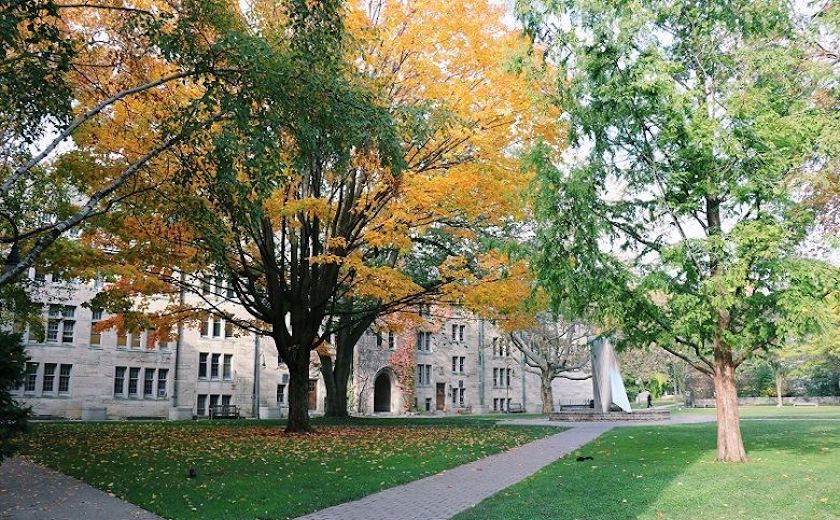
The Christianity and Culture Club is just one of many clubs and associations St. Mike’s offers, with a clubs fair held every fall for students to become acquainted with ways they can become involved. (Some events have been delayed or moved online during the pandemic.) Here are some examples.
- The Book and Media Studies Student Association represents students in the two streams of the program, hosting workshops, social events, and lectures.
- Build SMC is a student-run club that hosts Minecraft events and provides an online space to come together in creativity.
- The Celtic Studies Student Union offers lectures, workshops, Irish cultural events, and an annual Academic Journal, the Garm Lu.
- Clean SMC promotes clean initiatives to support sustainable development across the college, focusing on three main goals: building awareness, increasing community involvement in sustainable activities, and developing environmentally friendly projects.
- The Italian Undergraduate Student Cultural Association (IUSCA) works to establish, maintain and further ties with Italian culture among undergraduate students via academic, cultural and social events.
- The Medieval Studies Undergraduate Society offers lectures, workshops, an annual Medieval Studies Undergraduate conference, and other events.
- Pair-A-Dice is a board game club designed to help students meet their peers and create friendships.
- Rosa Sanctissimi is a weekly ecumenical prayer group that uses scripture and Divine Liturgy to guide discussion and community prayer.
- SMC Inclusive’s primary purpose is to represent people who identify as queer or transgender (LGBTQ+), encouraging the queer and trans community and playing an active role in fighting discrimination through both education and social means.
- The St. Michael’s College Troubadours, St. Mike’s drama society, has a goal of putting on a full season of productions (about four shows throughout academic year), showcasing voices and stories of U of T.
- University of Toronto Students for Life offers workshops, talks, and events that discuss Catholic Social Teaching and especially the dignity of the human person.
- USMC Wellness hosts de-stressing, community-driven and community-building events, providing spaces, resources, and a community for students to take care of their wellness in all forms, whether physical, mental, emotional or spiritual.
From University of St. Michael’s College President’s Report, Spring 2021
As Fall classes get underway, Interim Principal Mark McGowan reflects on the rich culture of research and education that characterizes St. Michael’s in this story from the Spring 2021 President’s Report.
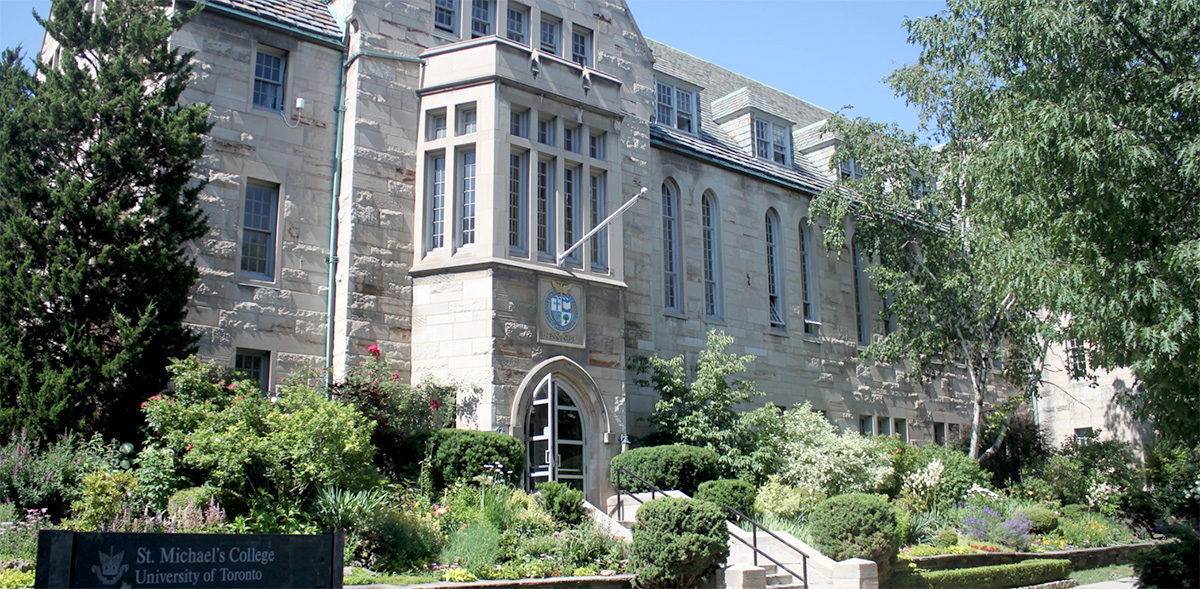
For Interim Principal Mark McGowan, the purpose of a university is clear: to help students—and the world—pursue the important questions. “The research toolkit that is part of the humanities teaches you to seek out data and weigh evidence in the pursuit of truth,” McGowan says. “These skills are portable and can go with you throughout your life, whether you are presenting at a school board meeting or at the board room table.”
For St. Michael’s, responding to life’s big questions means a continued focus on opportunities for students and faculty to study and conduct research, attend major conferences, share their results, and engage with the broader academic community.
“Faculty research and student research energize each other,” McGowan says, noting that events such as the recent research colloquium for St. Mike’s students on “Citizenship, Community, and Belonging”, as well as a university-wide colloquium on “The Role of the Catholic University in the 21st Century”, are indicative of the ways in which this engagement spills out of the classroom and into the broader life of the university.
“It is vitally important to continue to build a research culture on campus, engaging faculty in meaningful, innovative work while also encouraging students,” he says. “This is not just in-the-moment work but efforts that have long-term payoffs.
“There are many ways and resources to help answer the big questions,” he continues, citing for example important grants that have been awarded to support both faculty and student research and to fund attendance at major conferences, enhance classroom space for new approaches to teaching and ways for students to connect and, of course, the ongoing attention to the John M. Kelly Library, one of the University of Toronto’s finest.
Efforts continue to build up the four undergraduate programs St. Michael’s sponsors—Book and Media Studies, Mediaeval Studies, Christianity and Culture, and Celtic Studies as well as the three first-year seminars—the Gilson Seminar in Faith and Ideas, the McLuhan Seminar in Creativity and Technology, and the Boyle Seminar in Scripts and Stories—which weave themselves naturally into St. Mike’s undergrad programs.
McGowan notes, for example, that an increasing number of cross-appointments for St. Michael’s faculty members to the University of Toronto allows them both the joys of teaching in an intimate college classroom while also the exposure of working at U of T, the top-ranked Canadian university in the SQ World University Rankings 2021, with U of T ranking 25th in the world.
The resulting benefit, he notes, isn’t just for professors. Dr. Alison More’s cross-appointment to U of T’s Centre for Medieval Studies, for example, means she can easily reach out to colleagues at the Faculty of Music, the Department of Art History, or any of the divisions that might have crossover with her own work, expanding not only her scope but that of her students at St. Mike’s.
As the university looks to the future, McGowan notes there will be an increased emphasis on hiring with diversity and inclusivity in mind, building a team reflective of the student body.
This comes as the university considers and adopts ways for faculty and staff to work even more closely together.
“I don’t think in terms of divisions but see ourselves as one unit,” McGowan says, citing professors teaching at both the undergraduate level as well as in the Faculty of Theology.
“We are blessed with a strong teaching faculty, and a collection of really good people working throughout the university. This is just the beginning for us.”
From University of St. Michael’s College President’s Report, Spring 2021
Former St. Michael’s College Student Union president Cianna Choo reflects on the role of the student union in building community at St. Mike’s.
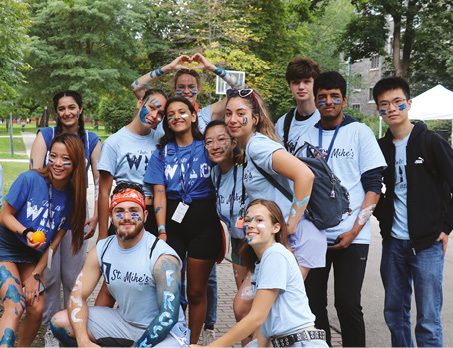
Cianna Choo attended her St. Mike’s orientation in the fall of 2018 and never looked back. “I fell in love with St. Mike’s instantly. The pride you feel walking along Bloor St. screaming cheers,” she recalls. “I knew I wanted to be involved.”
Soon she found herself immersed in activities and has done everything from sitting on a search committee to serving as one of two orientation coordinators for incoming students this past fall.
Today, the 3rd-year Neuroscience, Molecular Genetics and Microbiology student has just finished her term as president of the St. Michael’s College Student Union (SMCSU).
“Whether during COVID or during regular, on-campus times people are looking for a place to fit in while also looking for people who challenge them to think differently,” Choo says in explaining the attraction of St. Mike’s for students. SMCSU wants to engage St. Mike’s students no matter where they are studying on campus, and we have a goal of seeking collaboration. We have around 5,000 students and not all are on the same path.”
One of the places where SMCSU is seeking that collaboration is at the St. George Round Table (SGRT), a student union comprised of divisional student society heads at U of T.
“I feel I’m being heard at St. Mike’s,” Choo says, but with so many students studying across U of T, it is important that she, as a student spokesperson, raise St. Mike’s students’ ideas and concerns to U of T’s community as well.
At St. Mike’s, SMCSU continues to brainstorm and talk to President Sylvester on important issues such as increasing health and wellness supports for students.
“When you’re struggling academically or personally, it is really important that wellness services are accessible and that St. Mike’s can respond immediately,” she says.

SMCSU’s eye on collaboration also means being conscious of the balance of caring for both residence and commuter students.
“We are passionate about ensuring that what we give to residence students we give to commuter students too. We are hoping to balance these plans by increasing gathering spaces for commuters, such as creating a larger commuter lounge.”
While attentive to traditional student activities such as Friday night socials to bring students together at St. Mike’s, the student leadership team is also focused on issues such as carving out more support for international students.
“International students pay high fees and are often far from home. They are our students and we need to help them feel welcome, feel at home.”
Whether speaking with commuter students or residence students, those from across the globe or from suburban Toronto, Choo says her advice to new students is the same: “Try as many things as you can. Explore and be open to opportunities you might not have considered before. Each experience is a chance to learn more about yourself.”
From University of St. Michael’s College President’s Report, Spring 2021
For Dean of Students Duane Rendle, a welcoming environment at St. Mike’s is much more than just bricks and mortar.
Dean of Students Duane Rendle has three key goals as he works daily with students. He focuses on building a welcoming community, promoting student wellness and respecting diversity. “We want St. Mike’s to be a welcoming place to live, work and study,” says Rendle, who cites ongoing plans to renovate dorm rooms as one of the many ways the university is trying to fulfill these goals. Recent renovations in Elmsley Hall, which still had its original 1950s built-in furniture and green linoleum flooring, transformed those rooms to spaces that are especially popular with students.
A committee is currently examining how best to renovate the Queen’s Park building, to provide students with dorm rooms and classrooms that have modern amenities and a refreshed aesthetic.
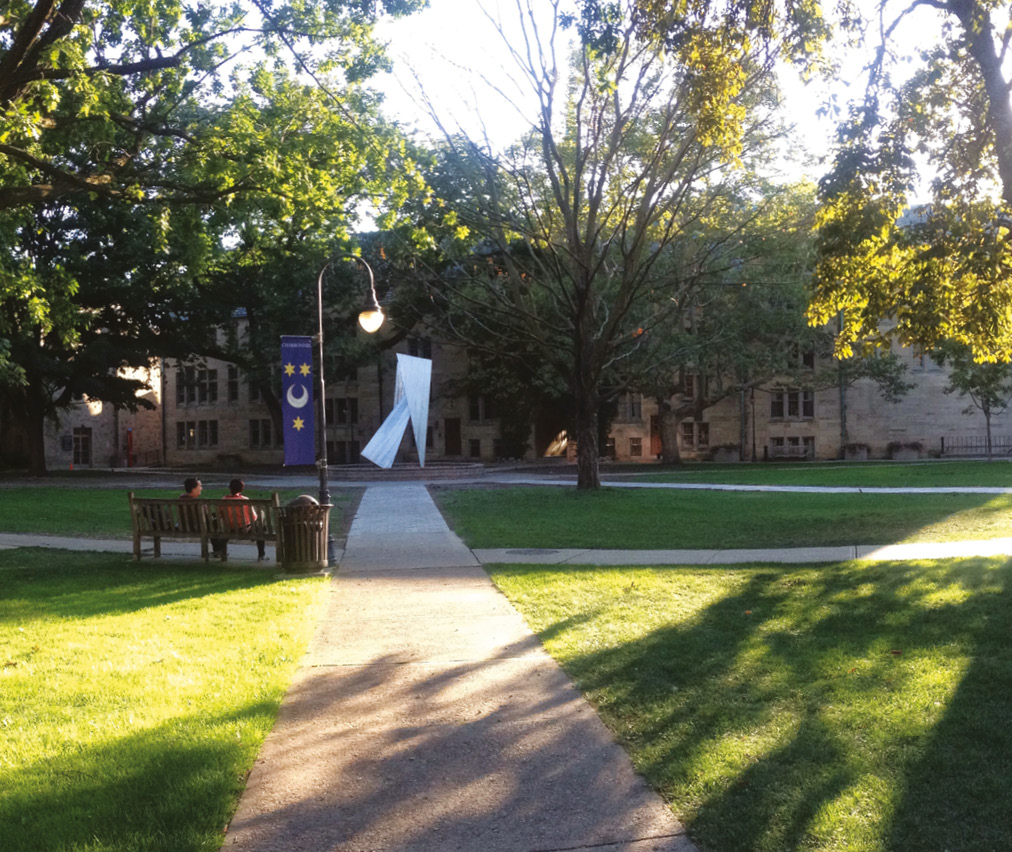
But a welcoming environment at St. Mike’s is much more than just bricks and mortar. For example, Rendle sees one of his team’s roles, which includes both residence and commuter dons, as educating students on issues of importance to the university community. He cites the online harm reduction course his office created a few years ago, Alcohol ABCs (Always Be in Control), as a way to provide students with strategies on how to consume alcohol safely. He is also an advocate for modelling responsible behaviour.
“You want to learn from your mistakes while you’re at university, not when you’re at your first job,” he says. “This is a safe, supportive community where people look out for each other.”
Being welcoming at St. Mike’s also means truly caring for students’ wellbeing and happiness and finding ways to support it.
Rendle offers particular praise for SMCSU, the St. Mike’s student union, for reaching out to Interim Principal Mark McGowan and President David Sylvester on the important issue of student mental health. The students respectfully advocated for increased access to counselling as well as expanded training for student leaders, so they can correctly recognize the signs of mental distress and refer students to appropriate resources.
“There is a maturity about these students that is really impressive. When they identify issues that are adversely affecting students’ mental health, they offer thoughtful and creative recommendations on how they can be addressed,” he says.
As for Rendle’s third pillar, respecting diversity, he says: “We function in one of the most cosmopolitan cities in the world, which is a tremendous asset in our increasingly interconnected existence. We want our students to learn from each other, to support each other and to celebrate what makes them unique. That’s why we are expanding our EDI (Equity, Diversity, and Inclusivity) training and making it available to more and more of our student leaders.”
While he doesn’t list it as a fourth goal, Rendle also says he wants to see graduates share the talents that were fostered and nurtured while on campus with the rest of the world.
“My own experience living at St. Mike’s was transformational. Yes, I learned a lot in my classes, but it was the experiences I participated in outside of the classroom that made me the person I am today.”
From University of St. Michael’s College President’s Report, Spring 2021
With a new name, award, and enhanced value, St. Michael’s longstanding program in Corporate Social Responsibility entered a new phase last fall. The changes came not long before COVID-19 would create a context in which working for the common good — a signature emphasis of the program — would take on a new meaning.
“The Corporate Social Responsibility program is a vital offering at the University of St. Michael’s College, helping business and institutions focus on ways to become better — and more effective — global citizens, whether environmentally, socially, or economically,” says St. Michael’s President David Sylvester.
While today’s global citizens uphold the common good by practising social distancing to slow the spread of COVID-19, the changes wrought by the virus will create new context and opportunities for creating social impact in a post-pandemic world. Graduates of the St. Michael’s diploma program will be among the first to imagine new possibilities for our life together when social distancing is no longer required.
The CSR program is featured in the latest issue of St. Michael’s Alumni magazine, and reproduced below.
A Season of Transformation for St. Mike’s CSR Program
Updated name, new award, enhanced value all signs of program’s coming of age
No matter what stage of life you’re at, icebreakers can help the first day of school seem a little less daunting. But when the school is St. Mike’s, and the subject is corporate social responsibility, you can forget about standard tension diffusers like ‘tell two truths and one lie about yourself’ or pinning your birthplace on a giant map.
As participants in the 2019/2020 Graduate Diploma in Social Responsibility and Sustainability cohort met for the first time this past October, students were asked to chat with a seatmate and then present that person to the group by naming their core values. As the introductions circled Charbonnel Lounge, words like honesty, gratitude, compassion, respect, integrity and humour surfaced, indicators that this is not just any classroom.
For close to 20 years, University of St. Michael’s College has been the go-to school in Canada to study Corporate Social Responsibility, an operational philosophy also known by a variety of other labels, including ESG (Environmental, Social, and Governance), Corporate Citizenship, or Social Purpose and Social Innovation.
The common thread is an institution’s commitment to action that enhances the common good by adopting strategies such as environmentally friendly processes, fair labour practices, or corporate volunteer efforts. Proponents of CSR argue that a strong strategy can have multiple benefits, from answering shareholder concerns and aligning with a board’s ethics through to self-preservation and furthering employees’ sense of participation in something valuable, all factors that can contribute to a stronger bottom line.
“Corporate Social Responsibility is not just a set of [business] tools but a new outlook,” Program Manager Kathryn Cooper explains. “CSR helps you look at people in a more human way and, as such, it is transformational.
“When we talk about Corporate Social Responsibility or Citizenship, we talk about social and environmental impact. Today investors, consumers and global citizens want to know that organizations are not causing social or environmental damage. In fact, there is an expectation that companies are making a positive contribution to society and the planet.”
As an example, she cites athletics apparel giant Nike as a cautionary tale. When negative media reports on its international labour practices surfaced in 1996, stock value fell by 50% from $38 to $19 per share, while sales dropped almost 10%.
It is precisely the goal of positive change that makes St. Mike’s a logical host for the program, says University President David Sylvester, because the program’s goals and outcomes represent the long-standing values of St. Michael’s. There is a clear correlation, for example, between the topics studied in the program and the tenets of Catholic Social Teaching, whether the issue is environmental stewardship, concern for the marginalized or a driving interest in the common good, he explains.
As it approaches its third decade of operation, the St. Mike’s program is undergoing its own transformation, a sign of a coming of age not only of the program but also for the concept itself.
This past Fall, the program name of Corporate Social Responsibility was changed to the Graduate Diploma in Social Responsibility and Sustainability. Corporate no longer appears in the program name because the core concepts’ appeal reaches far beyond the business world. While the idea began with financial institutions, it is now being embraced by a variety of sectors, including health care, education, NGOs, and not-for-profit organizations, notes Cooper. Recent graduates from the St. Michael’s program have come from a diverse group of employers, including Toronto Hydro, Manulife Financial, the University of Calgary, and UNICEF.
“The idea of social responsibility used to be viewed as a public relations issue or the way to earn a ‘social licence to operate’, but it’s got far wider applications,” she says.
Sustainability has been added to the program’s name “in response to a global trend toward embedding environmental, social and governance issues in business,” Cooper adds. “To survive and thrive, organizations must focus beyond their bottom line, and create positive social impact.
“We make a lot of personal connections between values and ethics and urge people to take their whole selves to work.”
The name change also signals the program’s upgrade from a certificate to a diploma. Graduates of the 2018/2019 cohort were the first to receive diplomas at their November convocation, and are eligible to use the post-nominal letters G.Dipl.SR&S. The upgrade is a result of the increasingly academic nature of the program, says Dr. Sylvester, who notes that when the motion to change the program to a diploma was put before St. Michael’s Senate, it was unanimously approved.
The changes to the CSR program come as St. Mike’s engages in its own strategic visioning exercise, notes Dr. Sylvester. St. Mike’s 180, Rooted in the Future seeks input from community members, asking how St. Mike’s can create a dynamic and abundant future as the school looks to its 180th anniversary in 2032.
St. Mike’s, like many other Canadian post-secondary institutions, is beginning to think more about the social impact of universities, and is looking to imbed related language and goals, examining everything from purchasing and infrastructure to examining a school’s relevance and how it engages with the community, he adds.
“We want to turn research and teaching on the community as a vibrant force, because universities must be engaged in the community to have relevance,” Dr. Sylvester says.
The Social Responsibility and Sustainability program at St. Mike’s runs over 13 months, and consists of three sets of in-class sessions throughout that period, for a total of 11 days on campus. In between the three on-campus sessions, participants engage in reading assignments, participate in webinars, post reflections, meet with mentors who provide advice and guidance on a capstone project, and stay in touch as a cohort through a special web portal. As each cohort is capped at 30 students, both participants and instructors get to know each other well, with plenty of time for discussion.
On-campus sessions include workshops on everything from making the business case for social and environmental responsibility to how to apply CSR and sustainability strategies in the workplace through the development and implementation of diversity and inclusion, community investment, ethics and reporting and communication policies and procedures.
The program draws three types of participants, Cooper notes. Some are tapped on the shoulder by employers wanting participants to develop their company’s CSR or Sustainability Strategy. Others are looking for a purpose-focused mid-career transition, while a third group consists of younger people who have graduated with theoretical knowledge about sustainability and CSR but are looking to learn from mentors and program participants with practical experience.
Participants have two major assignments, as well as a capstone project where they work with a seasoned CSR and sustainability mentor to undertake a practical social responsibility and sustainability project. Students identify their project’s outcomes and methodology, as well as how to socialize the plan with key stakeholders, she explains.
Past projects have included Community Investment Strategies, Volunteer Programs, Environmental Sustainability Initiatives, Indigenous Impact and Sustainability Reports and CSR/Sustainability Strategies.
The ability to connect with experts, as well as to meet others in similar fields grappling with similar questions, is one of the big draws for the program, graduates note.
“It’s a top-notch program, the only one of its kind in Canada connecting like-minded people with similar passions in Corporate Social Responsibility,” says Alexandra Biron, who is Assistant Manager, Corporate Responsibility at professional services firm Deloitte in Toronto. She looked at online offerings from other schools but was drawn to St. Mike’s both because of the in-person sessions, as well as what she heard from former students.
“You can find a lot of information online but the network of professors and speakers is what’s most valuable. You are a cohort with a diverse group in terms of age, sector, experience, background, and even with those who might not come from a CSR background but are looking to change fields,” Biron explains. “These people share their struggles and high points, especially as so much can happen in 13 months. These are people with similar values and passions in a variety of jobs.”
Biron was one of the two winners of the inaugural President’s Capstone Award this past Fall for her project, entitled Deloitte Canada 2019 Indigenous Impact Report, which examined the impact [Deloitte has] made with Indigenous communities through pro bono work, volunteering, donations, sponsorships or serving as directors on boards.
“This report was the first of its kind for the firm. We publish an annual CR report but this was the first time we looked at the impact we were having with Indigenous communities. It’s led to an even bigger project, which is the firm’s Reconciliation Action Plan, which is set to launch in 2020 and will set the stage for how Deloitte will move forward on implementing TRC recommendations into its corporate life.”
Like Biron, Sarah Thirnbeck credits the program with offering her the skills to lead change in her workplace. Thirnbeck, who is Associate Director of Strategic Impact for the Canadian Real Estate Association in Ottawa, says of the program, “It changed my life.”
When moved from handling social media into her current duties this past Fall, Thirnbeck sought a program to help her create a vision for her new role.
While seeking resources online, she found mention of the St. Mike’s program “and it fulfilled all my expectations. I arrived on Day 1 knowing I wanted to develop a CSR strategy for my organization but I became like a sponge, soaking up information.”
Thirnbeck was the other winner of 2019 President’s Capstone award. Her project was titled “A CSR Strategy for the Canadian Real Estate Association.” It has already had an impact, as the Board of Directors of CREA agreed to include ethics, sustainability and social impact as a new priority in its strategic plan, based on her recommendation.
Now, she will begin implementing ideas from her project, including a green strategy, in her own office, with an eye to rolling them out to various local boards and offices across the country.
Program graduate Robert Waite now serves as a CSR mentor, working with and inspiring other students. Waite found himself in the program in 2008 while working at Canada Post, after he was asked to lead the effort of Crown Corporations in the area of environmental stewardship. Deciding he wanted an academic understanding of the program, he chose St. Mike’s because “I liked the structure. …It was more humanistic and less technical, with more emphasis on the soft skills. The program gave me the tools I needed,” says Waite, who went on to produce the first CSR report of any Crown Corporation, and hosted a meeting of various Crown Corporations to share best practices.
Waite, who now teaches at Seneca College and does consulting, says he decided on the St. Mike’s program for several reasons, including the fact that the small program, on a small campus within the enormous University of Toronto campus, had an intimacy to it.
The very nature of a liberal arts college is another, he adds.
“Climate change, for example, can be positioned as a moral issue, a philosophical one,” he says.
A few years after graduating, he was invited by a United Nations official to lecture on CSR to a group of postal agencies from 10 Caribbean countries.
“The materials I used were materials I gathered from St. Mike’s. It was a great feeling, as many participants’ countries were small and didn’t have the resources to take on issues like environmental stewardship. My ability to say yes can be tracked to my participation in the program. I have nothing but praise for the people who run the program.”
One of the influences he cites is Dr. Mimi Marrocco, who started the program in 2002, when she ran St. Mike’s continuing education program. In chatting with various stakeholders, it became clear to Dr. Marrocco that “the liberal arts had something to contribute to business, including creating the time to think,” she recalls. “Liberal arts allows for reflection.
“Sometimes, work environments can become siloed, but this program creates a forum to talk to like-minded people, and it presents the opportunity to make connections inside and outside.”
One of Dr. Marrocco’s first ideas for the program was to introduce a novel study to allow people to use their right brain, the hemisphere associated with creativity and innovation.
The first year, participants read E.M. Forster’s Howards End, which bears the epigraph Only Connect, a message she says underlines the program.
“We need slow knowledge, slow movements. We are busy people in business and
sometimes we fall into busyness, which doesn’t allow us to use the whole person.”
New grad Alexandra Biron agrees.
The program “provided me with a platform to combine my professional life and one of my passions…. My career may not have progressed the way it did so quickly without this experience.”
By Catherine Mulroney
From St. Michael’s Magazine: Winter 2020
Note: This article was written before the COVID-19 pandemic. While athletics are central to St. Michael’s, current social distancing measures have put this part of campus life on hold.
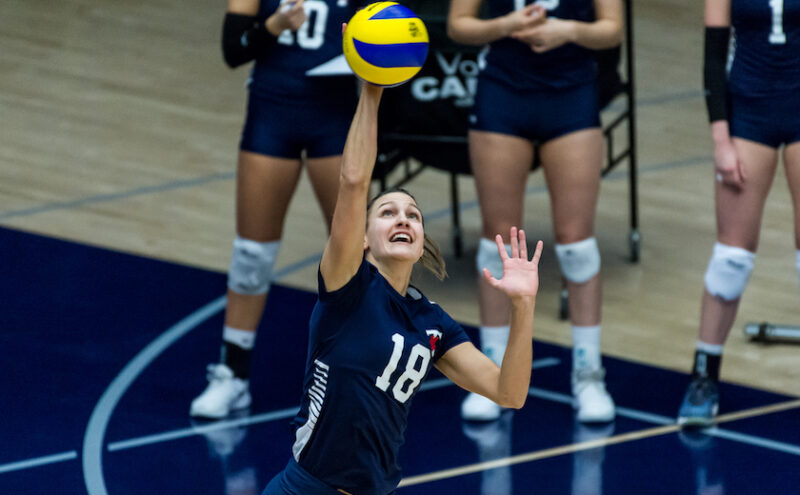
Central to St. Michael’s since its founding, athletics continues to reflect our commitment to educating the whole person
A new skating rink in the quad is the latest reminder that athletics matter to the University of St. Michael’s College. Walk through campus and you’ll see a pick-up game of basketball or a quick toss of a Frisbee outside the COOP. Intra-mural teams are thriving, and we currently are home to 98 varsity athletes, competing in 21 different sports.
It’s no accident that St. Mike’s has a storied history of athletics. One of our guiding principles has always been that supporting athletics reflects a commitment to the formation of the whole person, with the physical rigours of the playing field complementing the intellectual rigours of the classroom.
Athletics also serve as a major source of community and school spirit, whether students are involved primarily with an intramural team or with a nationally ranked Varsity Blues squad. Participation offers a way to develop gifts shared in community, an expression of our calling to service.
St. Michael’s has long been a sports powerhouse. As noted in Edward J. Monahan’s (USMC Class of 1949) Teach Me Goodness, Truth and Knowledge: A History of St. Michael’s College, for example, in the first half of the 20th century, St. Mike’s rose to become a regional centre of collegiate athletics. We even had Basilians competing for St. Mike’s: one notable example is Father David Bauer, who helped a 1945 SMC team win the Memorial Cup, and who gave up a career in the NHL to join the priesthood. He later coached Canada’s Olympic hockey team, and was admitted to the Hockey Hall of Fame posthumously in 1988.
Today, a whopping 33 members of this year’s Varsity Blues Football team call St. Mike’s home, attracted by our reputation for being a supportive community aware of the importance of athletics. We can say with confidence that St. Mike’s is the college of choice for athletically minded students.
My introduction to St. Mike’s athletics came when I moved into residence here as a student in 1995. In May of that year I flew to the Big Smoke from Victoria B.C. to find a place to live for the Fall. I knew only one person in Toronto, a former high school classmate named Laura. She nixed my idea of searching off-campus, telling me to look for a dorm. When I asked for a recommendation, she said: “St. Mike’s. It’s Catholic, it’s a big sports college and it’s right across the street.” The prospect of living close to my only Toronto friend became even more appealing after meeting her roommate, a beautiful Victoria College student to whom I’ve now been married for the past 18 years, but I digress.
I soon discovered why Laura referred to St. Mike’s as a “big sports college.” The residence houses all competed for the coveted Dean’s Cup sports trophy, the College’s teams were perennial contenders in U of T’s intramural leagues, and St. Mike’s was the only college to have its own fully stocked weight room.
One day, as I chatted with housemates in the Canada Room, one of the dons dropped by to say he’d been asked to recruit players for the annual ‘alumni vs students’ football game. Our group didn’t ask many follow-up questions because it sounded like the perfect way to spend a Fall afternoon.
But it wasn’t until I played in that Boozer Brown game in mid-October that I realized how deep the sports roots ran at St. Mike’s. U of T’s football program had run from 1895 to 1994, for example, and during that 100-year span, St. Mike’s had won the Mulock Cup 12 times, including ‘back-to-back-to-back’ victories the final three years. No wonder former players were so eager to relive their glory days.
The alumni team was composed of players from a now-defunct intra-mural league that used to play tackle football. Due to liability issues the tackle program had folded a couple years prior, but the alumni weren’t about to let their annual tradition die with the league. These guys were premier athletes in their day and this game was an excuse to return to their alma mater and prove they hadn’t lost a step.
As our respective squads began running drills, I sized up the competition. Some looked older than my father while others appeared younger than my then-25-year-old self. St. Mike’s jerseys of uncertain vintage were worn proudly but loosely due to the absence of pads, and a few of the old-timers brought their families along, lending a homecoming-type feel. Led by the larger-than-life booster Phil Giroday (USMC Class of 1977), our teams huddled up to go over the rules, flip the ceremonial coin and then the 27th installment of the Boozer Brown got under way.
It was obvious the alumni had come to play. I was stunned to hear their quarter-back calling plays – actual football plays like, “red dog five hook left” and “blue right 30 pull trap.” The ragtag group our dons had assembled possessed lots of talent but the coordinated approach of the alumni, coupled with the ‘creative officiating’ of former coach Lex Byrd, made it clear the alumni would be leaving with bragging rights. When the final whistle blew, the alumni had six touchdowns and the students four; you would have thought they’d won the lottery. (Lex, by the way, had coached the St. Mike’s team from 1978 to1993 and had led the team to an astonishing eight Mulock Cup championships.)
While reliving highlights at a post-game BBQ with the victors, I learned that the alumni-student game had been taking place since 1968. It was named after Bud “Boozer” Brown, a student instrumental in St. Mike’s winning its first football championship in 1930, the coveted Mulock Cup. I remember thinking how fortunate I was to have ended up at a college tailor-made for sports-minded students like me.
I attended the Boozer Brown again the following year as a student and then in 1998, St. Mike’s hired me as their new Dean of Men, involving me in the game in a new way. By this point, the intramural football program had folded, and some wondered how we’d be able to keep the alumni game going. But U of T began awarding the Mulock Cup to the winner of its intramural rugby program and by the mid-2000’s, SMC’s team was a powerhouse, regularly competing for the championship. I was very involved with the team back then and would always explain the historic connection between the football and rugby programs — and would inform our players it was their duty to participate in the annual Boozer Brown game!
Eventually, the intramural rugby league was discontinued, and it was once again time to re-imagine how best to keep the spirit of the Boozer Brown game alive. It was alumni athletes who came up with a great way to create a new athletics tradition. In the summer of 2019, a group of alumni approached USMC’s Advancement Office wanting to create two scholarships, male and female, to honour Lex, their former coach.
We decided to morph our annual alumni-versus-student game into an annual alumni-plus-student reception for the new award. The event would still give our football heroes the chance to connect with their teammates, but a more inclusive event would mean their ranks could be joined by all the great athletes, women and men, who’d competed for St. Mike’s over the years.
On November 30, 2019, SMC hosted the inaugural Boozer Brown Athletics Reception in Charbonnel Lounge. In addition to our esteemed alumni, we had a great turnout from our current crop of varsity athletes, all of whom were introduced by name in President Sylvester’s remarks. The women’s recipient of the initial Lex Byrd scholarship was Varsity Blues hockey forward Melissa Bieman, who is currently studying History and Philosophy. She came to the reception directly from Varsity Arena, where the Blues had just defeated Waterloo to move into first place in the OUA standings. Varsity Blues wide receiver Liam Cousineau, a 1st-year student whose goal is a double major in Political Science and International Relations, was the men’s recipient.
Attendees had an opportunity to reminisce about the past as well as stoke excitement for the future. While there may no longer be an alumni-student football game happening on the northeast corner of the campus, rest assured that sports are alive and well—and thriving!—at St. Mike’s.
By Duane Rendle, Dean of Students
From St. Michael’s Magazine: Winter 2020
Photos courtesy of the University of St. Michael’s College Archive. Check out more photos of athletics at St. Mike’s here:


